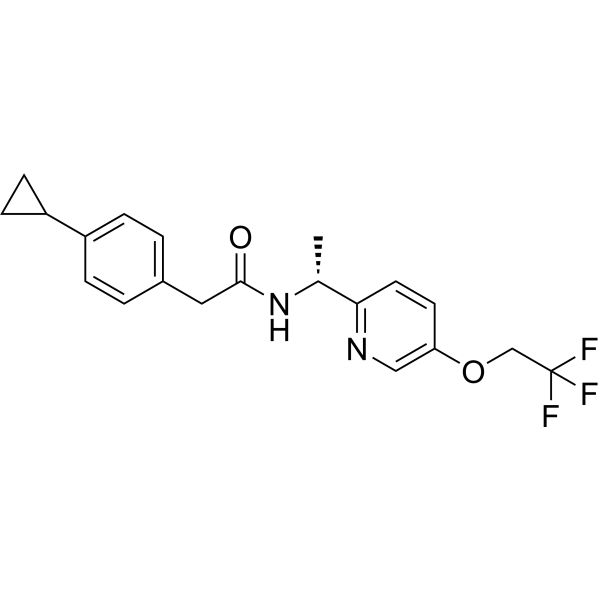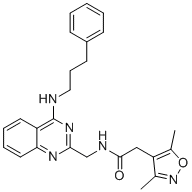 To enhance service speed and avoid tariff delays, we've opened a US warehouse. All US orders ship directly from our US facility.
To enhance service speed and avoid tariff delays, we've opened a US warehouse. All US orders ship directly from our US facility.
| Cat. No. | Product Name | Field of Application | Chemical Structure |
|---|---|---|---|
| DC40144 | TTA-A2 Featured |
TTA-A2 is a potent, selective and orally active t-type voltage gated calcium?channel antagonist with reduced pregnane X receptor (PXR) activation. TTA-A2 is equally potent against the Cav3.1 (a1G) and Cav3.2 (a1H) channels with IC50 values of 89 nM and 92 nM, respectively, at -80 and -100 mV holding potentials. TTA-A2 can be used for the research of a variety of human neurological diseases, including sleep disorders and epilepsy.
More description
|

|
| DC73598 | IPPQ Featured |
IPPQ is a small molecule that selectively target the interface between the N-type calcium (CaV2.2) channel and CaVβ, specifically binds to CaVβ2a and inhibits CaVβ2's interaction with CaV.2-AID (alpha interacting domain).
More description
|

|
| DC76742 | O-Desmethylcarvedilol |
O-Desmethylcarvedilol (Desmethylcarvedilol) is an active metabolite of the non-selective β-adrenergic receptor (β-AR) antagonist Carvedilol. O-Desmethylcarvedilol inhibits store-overload-induced calcium release in HEK293 cells expressing the ryanodine receptor 2 (RyR2) R4496C (RyR2R4496C) mutation (IC50 = 7.62 µM). O-Desmethylcarvedilol reduces increases in heart rate and prevents decreases in diastolic blood pressure induced by Isoproterenol in conscious rabbits (ED50s = 32 and 5 µg/kg, respectively).
More description
|

|
| DC76741 | Niguldipine monohydrochloride |
Niguldipine monohydrochloride is a calcium channel blocker that inhibits P-glycoprotein and can be used in tumor research. Niguldipine monohydrochloride inhibits Cav 3.2, with an IC50 of 0.9 μM.
More description
|

|
| DC76740 | Hexadecylphosphoserine TFA |
Hexadecylphosphoserine TFA is a phospholipid molecule that contains a long-chain alkyl (hexadecyl) and a phosphoserine group, giving it a high affinity for the cell membrane. Hexadecylphosphoserine TFA can exert antitumor activity by modulating [Ca++]i and its related signaling pathways, making it useful for research in the field of breast cancer.
More description
|

|
| DC76739 | Etripamil hydrochloride |
Etripamil (MSP-2017) hydrochloride is a short-acting, L-type calcium channel antagonist that can be used in the study of paroxysmal supraventricular tachycardia (PSVT). Etripamil hydrochloride inhibits calcium influx through slow calcium channels, thereby slowing atrioventricular node conduction and prolonging the atrioventricular node refractory period.
More description
|

|
| DC76738 | dl-Tetrandrine |
dl-Tetrandrine is an orally active and brain-penetrant calcium channel blocker that inhibits voltage-dependent calcium channels. dl-Tetrandrine selectively blocks Ca2+ influx with an IC50 value of approximately 1-10 μM. dl-Tetrandrine exerts anti-inflammatory, immunosuppressive, and anti-arrhythmic activities by inhibiting intracellular calcium overload, and can reverse multidrug resistance in tumor cells. dl-Tetrandrine is promising for research of autoimmune diseases (such as rheumatoid arthritis), cardiovascular diseases, and tumor drug resistance reversal.
More description
|

|
| DC76737 | CGP 28392 |
CGP 28392 is an activator for calcium channel, and reactivates the oxygen evolution in calcium-deficient photosystem II (PS II) particles.
More description
|

|
| DC76736 | Cav 3.1 blocker 1 |
Cav 3.1 blocker 1 (compound 12) is a T-type calcium channel blocker with an IC50value of 160 nM for Cav3.1. Cav 3.1 blocker 1 weakly inhibits Cav 3.2 (IC50 of 5000 nM), and shows no inhibition on Cav 3.3 and Cav 1.2 (IC50 of >10000 nM).
More description
|

|
| DC76735 | AK-2-38 |
AK-2-38, a Nifedipine analogue, is a calcium channel antagonist. AK-2-38 also has partial agonist effects on isolated guinea pig left atrium.
More description
|

|
| DC76734 | Adenophostin A |
Adenophostin A is a potent inositol triphosphate (IP3) receptor agonist, which binds to IP3 receptors with high affinity and effectively stimulates the release of calcium ions (Ca2+).
More description
|

|
| DC76733 | 8-Br-7-CH-cADPR disodium |
8-Br-7-CH-cADPR disodium (7-Deaza-8-bromo-cADPR) is a potent cADPR antagonist. 8-Br-7-CH-cADPR disodium shows partial inhibition of calcium elevation caused by sTIR dimerization. 8-Br-7-CH-cADPR disodium significantly decreases Paclitaxel-induced axon degeneration.
More description
|

|
| DC76732 | (S)-Albuterol |
(S)-Albuterol is a muscarinic receptor and phospholipase C activator. (S)-Albuterol increases intracellular free calcium in airway smooth muscle.
More description
|

|
| DC76731 | (2R,3R)-Diltiazem hydrochloride |
(2R,3R)-Diltiazem hydrochloride is an isomer of Diltiazem hydrochloride. Diltiazem is an orally active L-type Ca2+ channel blocker. Diltiazem shows antihypertensive and antiarrhythmic effects. Diltiazem can be used for the research of cardiac arrhythmia, hypertension, and angina pectoris.
More description
|

|
| DC28967 | Gallopamil hydrochloride Featured |
Gallopamil hydrochloride (Methoxyverapamil hydrochloride), a methoxy derivative of Verapamil, is a phenylalkylamine calcium antagonist. Gallopamil hydrochloride inhibits acid secretion in a concentration-dependent manner with an IC50 of 10.9 μM. Gallopamil hydrochloride is a potent antiarrhythmic and vasodilator agent.
More description
|

|
| DC70883 | VK-II-86 Featured |
VK-II-86 is a carvedilol analogue lacking antagonist activity at β-adrenoceptors, effectively suppresses SOICR by directly reducing the open duration of the cardiac ryanodine receptor (RyR2).VK-II-86 exhibited >2,000-fold lower beta-AR binding affinity than carvedilol.VK-II-86 prevented stress-induced ventricular tachyarrhythmias in RyR2-mutant mice and did so more effectively when combined with either of the selective beta blockers metoprolol or bisoprolol.VK-II-86 prevented hypokalaemia-induced AP prolongation and depolarization but did not alter AP parameters in normokalaemia.
More description
|

|
| DC49692 | T-Type calcium channel inhibitor(TTA-P2) Featured |
T-Type calcium channel inhibitor is a potent inhibitor of T-Type calcium channel. T-Type calcium channel inhibitor penetrates well the CNS and blocks the native T-type currents in deep cerebellar nuclear neurons, the window current is completely abolished both for wild-type and mutant Cav3.1 channels. T-Type calcium channel inhibitor has the potential for the research of neurology disease.
More description
|

|
| DC73601 | TTA-Q6 |
TTA-Q6 is a potent, selective T-type Ca2+ channel antagonist with IC50 of 14 nM and 590 nM in FLIPR depolarized assaay and FLIPR hyperpolarized assay, respectively.
More description
|

|
| DC73600 | TMDJ-035 |
TMDJ-035 is the first highly potent and selective ryanodine receptor 2 (RyR2) inhibitor with EC50 of 13 nM, shows no effect on RyR1 and RyR3.
More description
|

|
| DC73599 | PST3093 |
PST3093 (PST 3093) is the main Istaroxime metabolite and a selective SERCA2a activator, reduces the SERCA2a KdCa value by about 20% at 100 nM.
More description
|

|
| DC73597 | Extracellular vesicle enhancer 634 |
Extracellular vesicle enhancer 634 (Compound 634) is a small molecule enhancer of extracellular vesicle (EV) release with immunostimulatory potency via induction of Ca2+ influx, which is mediated by store-operated Ca2+ entry (SOCE).
More description
|

|
| DC73596 | Efonidipine hydrochloride |
Efonidipine (NZ-105) is a potent, dual T-type and L-type calcium channel blocker, exhibits antihypertensive effect through vasodilatation.
More description
|

|
| DC73595 | 2D216 |
2D216 is a small molecule calcium channel activator, increases murine antigen-specific antibody responses when used as a co-adjuvant with LPS.
More description
|

|
| DC73594 | 2E151 |
2E151 is a small molecule calcium channel activator, increases murine antigen-specific antibody responses when used as a co-adjuvant with LPS.
More description
|

|
| DC10446 | (3R,4S,5S)-tert-butyl 3-Methoxy-5-Methyl-4-(MethylaMino)heptanoate hydroc hloride Featured |
Diltiazem hydrochloride is a calcium ion influx inhibitor (slow channel blocker or calcium antagonist).
More description
|

|
| DC10532 | Mirogabalin besylate Featured |
Mirogabalin (DS-5565) is a novel, preferentially selective α2δ-1 ligand characterized by high potency and selectivity to the α2δ-1 subunit of voltage-sensitive calcium-channel complexes in the CNS.
More description
|

|
| DC42326 | Azumolene Featured |
Azumolene (EU4093 free base), a Dantrolene analog, is a muscle relaxant. Azumolene is a ryanodine receptor (RyR) modulator and inhibits the calcium-release through ryanodine receptor. Azumolene can be used for malignant hyperthermia research.
More description
|

|
| DC72651 | SG-094 Featured |
SG094 is a potent TPC2 inhibitor with antiproliferative effects. SG-094 can be used for the research of cancer.
More description
|

|
| DC9856 | NS638 Featured |
NS638 is a Ca(2+)-channel blocker.
More description
|

|
| DC9706 | ABT-639 Featured |
ABT-639 is a novel, peripherally acting, selective T-type Ca2+ channel blocker. ABT-639 blocks recombinant human T-type (Cav3.2) Ca2+ channels in a voltage-dependent fashion (IC50 = 2 μM) and attenuates LVA currents in rat DRG neurons (IC50 = 8 μM).
More description
|

|